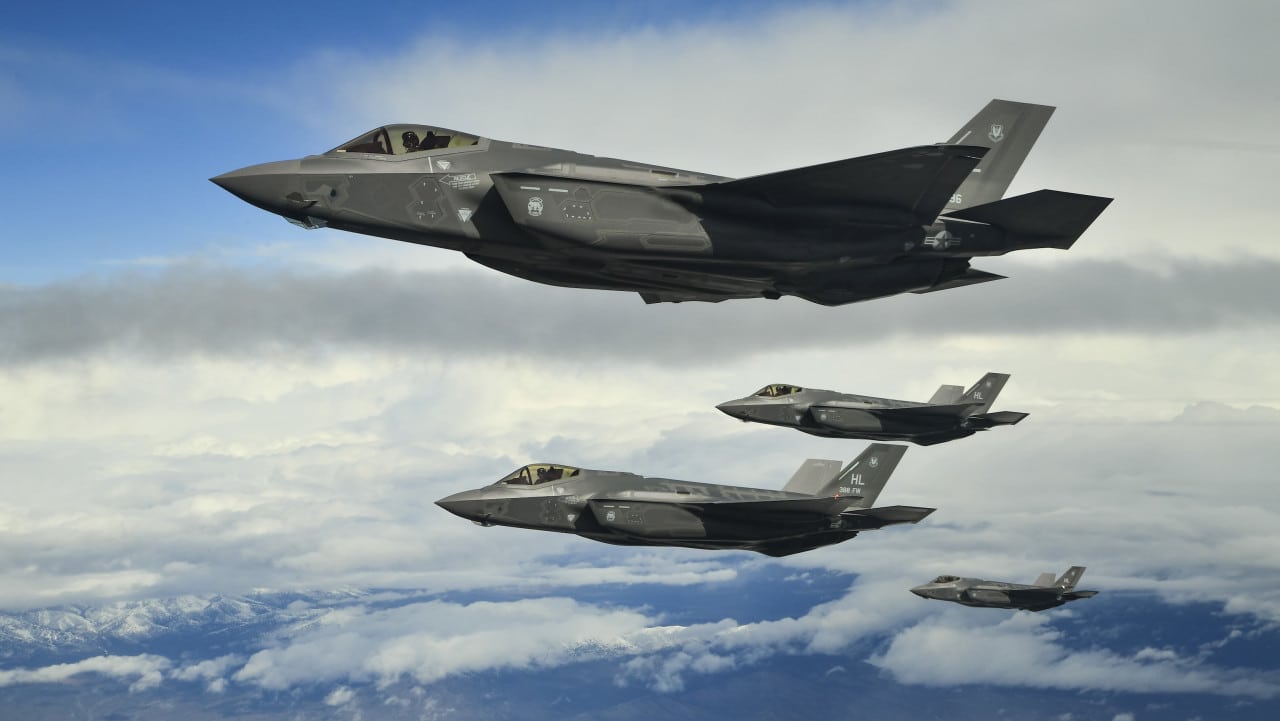
A squadron of F-35As flying over Hill Air Force Base in Utah. Photo courtesy of U.S. Air Force
Impending changes to the F-35 Joint Strike Fighter management structure are a natural result of the program moving from development to production, according to Joint Program Office Chief Vice Adm. Mat Winter.
“As we look forward, every weapon system in the United States at some point has changed its program office management structure to reflect the realities of the program phase,” Winter said at the U.S. Navy League’s annual Sea-Air-Space exposition. “The current F-35 enterprise program phase is not like any other program office that I have been associated with. We will be in full sprint in development, production and sustainment for the next 20 years.”
So far, more than 280 F-35s in three variants have been delivered to the Navy, U.S. Marine Corps, U.S. Air Force and international partners in the program including the U.K., Israel and Australia. Winter said system development demonstration testing on the aircraft and its attendant systems is set to conclude some time this week, marking a major milestone toward a full-rate production decision.

The U.K.’s first F-35 taking its first flight.
(Photo courtesy of Lockheed Martin)
The program suffered a setback the same day Winter spoke at the exposition when Reuters reported that the government had suspended receipt of the jet from Lockheed Martin because of corrosion found where the jet’s carbon fiber outer skin joins the airframe. Deliveries were halted for about a month last year when the corrosion was discovered. The current delivery halt is the result of a dispute over who will pay to fix the problem, which will require costly deployment of Lockheed Martin personnel worldwide, according to reports.
Winter did not mention the delivery halt during his Navy League appearance.
The dispute is the latest in a litany of costly development delays the program has suffered since its inception. Those delays forced the JPO to rebaseline the program in 2010 after which the government and Lockheed Martin have instituted a number of cost-reduction initiatives and efficiency plans.

The first South Korean F-35, recently revealed. Photo courtesy of Lockheed Martin Aeronautics
Congress in fiscal year 2017 directed the U.S. Defense Department (DOD) to perform a study on the efficiency of the F-35 Joint Program Office management structure. Winter said an independent study was performed by a third-party contractor chosen by the Secretary of Defense that reached out to all the stakeholders including all three U.S. services buying the jet, international partners and industry.
The findings of that report were presented to former Defense Secretary Ash Carter, who did not act on them before the Trump administration installed Jim Mattis as the senior DOD civilian.
“The new administration took the prudent time to review that report and understand the underpinnings of that report,” he said.
Ellen Lord, who recently became the first Undersecretary of Defense for Acquisition and Sustainment, issued a memo March 27 that directed a reorganization of F-35 management under service-specific program offices instead of a unified JPO. The memo stated that, eventually, an Air Force office will oversee the F-35A conventional-takeoff-and-landing variant and a Marine Corps/Navy office will handle the F-35B short-takeoff-and-vertical-landing variant and the F-35C carrier variant.
“In order to effectively integrate and sustain the F-35 in the joint force, the military departments must have more direct ownership of the F-35 program and leverage organic capabilities, processes and infrastructure,” the letter said.

An Italian F-35 (Photo courtesy of Lockheed Martin)
Winter said many of the directives laid out in Lord’s cover memo, which he described as “infamous” after media extensively reported on its implications for the historically rocky program, were already underway before the letter became public. Ultimately, he said the Defense Department wants to ensure “that the JPO management structure will continue to be the most efficient and effective to design, deliver, produce and sustain the F-35 air system into the future.”
Lord’s memo called for appointing Air Force and Marine Corps colonels and a Navy captain to be “service deputies” in the JPO. The services each have a deputy program director already working within the JPO, according to Winter.
“The migration of the program office, the appropriate skillsets, the organizational alignment and how we will execute that will continue to mature and be assessed every year,” he added. “That is the direction I’ve been given. That’s what the cover memo intent is and that’s what we’re executing today.”